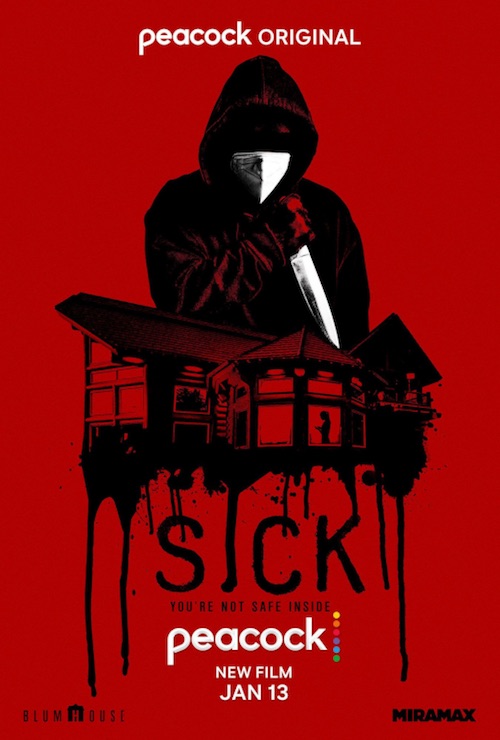
Movie Review: Sick
What We Liked
What We Didn't Like
While Sick will likely gain attention for its pandemic-driven premise, the new thriller from Scream (1996) screenwriter Kevin Williamson is much more than just a current events-capitalizing scary movie. Lean, intense, and smart, it’s one of the better recent additions to the slasher genre while also being a rare film with something to say about the COVID crisis.
The film takes place in April 2020, during the early days of quarantines, lockdowns, and toilet paper scarcity. College students Parker (Gideon Adlon) and Miri (Bethlehem Million) head to a cabin in the woods to ride out the pandemic and stay safe; they’re joined by Parker’s sort-of boyfriend DJ (Dylan Sprayberry) – as well as a masked killer intent on wreaking their own deadly havoc. It’s a simple premise, knocked out in a tension-filled 82 minutes.
The film’s first scene slams audiences back into those terrifying early-pandemic days, as a young man heads out to the store to buy supplies before hunkering down at home. While serving as an effectively suspenseful opening scene for a slasher movie, Williamson and director John Hyams also capture the paranoia and fear of the time. Parking lots and stores have a dystopian emptiness, everyone’s face is hidden behind a mask, and a cough from a stranger in line stops hearts. The mix of that relatable fear, goosed with some dark humor, adds to the eeriness and suspense.
There’s been no shortage of pandemic-set TV shows and movies, and most of them feel obligatory, incorporating the crisis without much to say about it. But Williamson and co-writer Katelyn Crabb are strong screenwriters with a knack for cultural commentary, and Sick is one of a few projects – including Steven Soderbergh’s Kimi and the horror movie Host – to use the pandemic setting wisely. Here, the shots of masked figures stalking silently through hallways and outside windows are a clever metaphor for a virus that seemed to lurk behind every corner, leaving us unsure who would be the next patient and how fraught their encounter with it might be. It exploits the way isolation enhanced our anxieties, leaving us to fend largely for ourselves, as anyone nearby could pose a threat.
But while the pandemic setting adds to the horror, Sick’s a slasher at heart, and works best when focused on the scares. It benefits from an economical script; there are three main characters plus the killer and one setting. The film wastes no time getting everyone to the cabin and bringing in the threat. The final half of the movie is a relentless and inventive series of cat-and-mouse pursuits, harrowing encounters and violent demises, only coming close to toppling over when its final reveals ladle on the COVID connections a bit too thick.
Sick is violent and has its share of gnarly moments, but Hyams smartly understands the importance of suspense. He largely steers clear of jump scares and overly grisly kills, instead he increases the tension by showcasing characters lurking in the background, undetected by the heroes but fully apparent to the audience. His camera work is clever and energetic, using the winding geography of the dark cabin to suggest threats behind every corner. He also brings back the power of a good chase sequence, something slasher movies tend to lose in their rush to get to the kills. Much of Sick involves frenzied dashes, near escapes, and heart-stopping reversals, with Williamson drawing on the ingenuity he showed in Scream to keep audiences on their toes. It’s the rare slasher that actually has real scares, although it would be nice if the killer had a more iconic look, rather than what I can only describe as “Spirit Halloween Ninja.”
The three leads create likable and smart characters, and the film never has them make the classic stupid horror movie decisions. They prove themselves resourceful, and there are several moments where they make the exact right decision, only for the script to deliver another clever twist or pull the rug out. Sick doesn’t cheat or condescend, and there’s an infusion of bleak humor that helps alleviate the tension in key moments. It might push its COVID inclusion a bit too far in the last act, breaking the suspension of disbelief (a plot point hinges on a rapid test, which weren’t available in April 2020), and like most slasher movies it isn’t the deepest or most rational of films. But it’s a solid piece of work in an subgenre too associated with cheap dreck.
Sick never seeks to elevate the slasher. Its not a reinvention, subversion or homage a la X, They/Them or Bodies Bodies Bodies. It’s just an example of the genre done right, with just enough cultural commentary to make it smart and a dedication to the art of suspense that should please fans. It’s a shame it’s a streaming exclusive; it’s a movie that would play well with a large crowd … as long as they’re all masked up.




